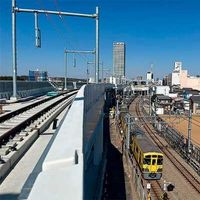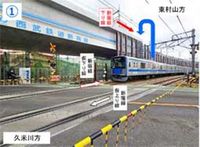In a significant infrastructure development, Tokyo authorities have announced the elevation of the Seibu Shinjuku Line near Higashimurayama Station, set to begin on June 29, 2025. This upgrade will transform approximately 2.3 kilometers of the line into an elevated track, aimed at alleviating traffic congestion on Fuchu Kaido, a major thoroughfare in the area.
The project, spearheaded by the Tokyo Metropolitan Government in collaboration with Seibu Railway and the city of Higashimurayama, is part of a larger initiative to enhance urban transit systems. The overall project will elevate about 4.5 kilometers of track, including sections of the Kokubunji Line and the Seibu-en Line, which are also slated for upgrades in the near future.
As part of this transition, the elevated section is expected to reduce the closing times at four railroad crossings, including the busy Fuchu Kaido, thereby easing the traffic bottlenecks that have plagued the area. The project is anticipated to improve safety and efficiency for both train passengers and motorists.
In conjunction with the elevation, new platform doors will be installed at Higashimurayama Station, enhancing safety for passengers. These improvements are being funded through a combination of government support and local initiatives, ensuring a comprehensive upgrade to the station's infrastructure.
Prior to the official switch to the elevated line, a facility tour is scheduled for June 1, 2025, allowing the public a chance to view the new installations. This tour requires prior application and will be available on a first-come, first-served basis.
Meanwhile, public transportation services in the area are currently facing disruptions. As of April 10, 2025, substitute transportation is being conducted on JR lines, Tokyo Metro, Toei Subway, Tobu Railway, Keio Electric Railway, and Tama Monorail, with some delays reported on the Seibu Ikebukuro Line and Seibu Shinjuku Line due to contact with obstructions.
The Seibu Railway's announcement of the upcoming changes comes amidst ongoing efforts to modernize transportation infrastructure across the Tokyo metropolitan area. The elevation of the Seibu Shinjuku Line is seen as a critical step in this direction, aimed at enhancing the efficiency of urban transit and reducing the environmental impact of road congestion.
In related news, the Kanto Transport Bureau has released accident statistics indicating that in 2023, there were 171 incidents involving truck drivers that resulted in death or serious injury, with a notable concentration of these accidents occurring between the hours of 10 PM and 6 AM. This alarming trend highlights the ongoing challenges faced by transportation authorities in ensuring road safety.
Additionally, upcoming road closures are set to affect traffic in the region. The entrance to the overpass on National Route 1 leading to Prefectural Route 65 will be closed to night traffic on April 21 and 22. Similarly, the Lake East Mikayama Smart IC will be closed starting May 7 for ETC construction, further complicating transportation logistics in the area.
As the region braces for these changes, predictions indicate a maximum congestion of 35 kilometers on the Kobe Awaji Naruto Expressway and the West Kobe Route during the Golden Week holiday from May 3 to May 5. This forecast underscores the need for ongoing improvements to transportation infrastructure to accommodate the growing population and increased travel demands.
In the broader context of transportation innovation, Volvo has recently unveiled what is touted as the world's largest all-electric concrete pump truck, signaling a shift towards more sustainable construction practices. Meanwhile, Toyota Auto Body has entered into a basic agreement with the Chubu Hydrogen/Ammonia Society Implementation Promotion Council, further emphasizing the industry's commitment to environmental sustainability.
As these developments unfold, the emphasis remains on improving public transportation systems and enhancing road safety. The elevation of the Seibu Shinjuku Line is just one of many projects aimed at addressing these critical issues, reflecting a commitment to modernize and improve urban infrastructure for the benefit of all residents.
With the June 29 elevation date approaching, residents and commuters alike are keenly watching the progress of this significant infrastructure project. The hope is that these enhancements will lead to a smoother, safer commuting experience for everyone in the Tokyo area.






